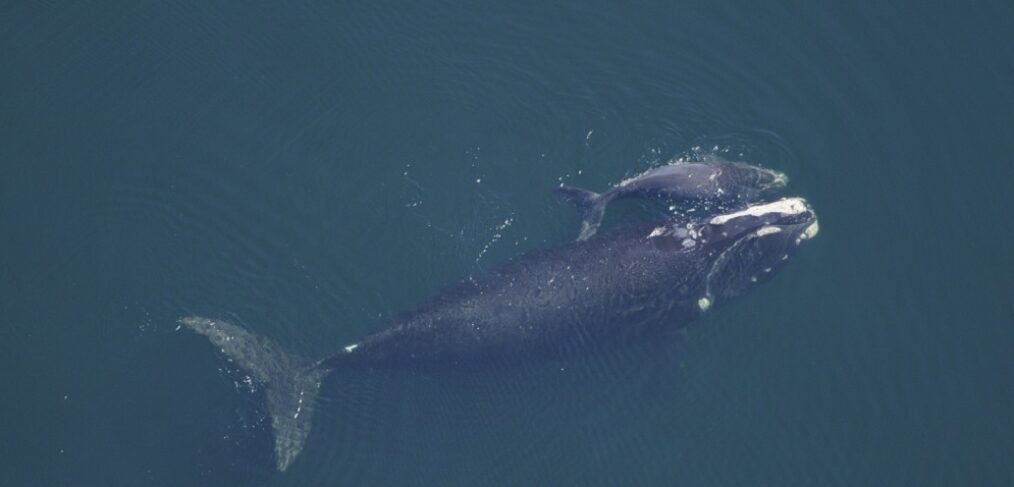
species of the week #95- North Atlantic Right Whale
The North Atlantic Right Whale is a slow swimming baleen whale up to 18 m long. Its leisurely drifting on the surface, its thick layer of fat and oil, and the fact that killed animals do not sink, have earned it the name “right whale”. For the whalers it was the most lucrative and easiest prey to hunt.
| Distribution status in Europe | Threatened with extinction |
| Remaining occurande | Atlantic |
| Last sightening in Europa | current |
| Habitat | Atlantic coast |
| Threat | Shipping accidents, bycatch, climate change |
Despite their strong stature, North Altantic Right Whales are surprisingly acrobatic. They frequently leap out of the water and strike the surface with their pectoral fins. As they exhale, they produce a characteristic V-shaped fountain from their two blowholes. North Atlantic Right Whales are roundish in stature and mostly black. They have no dorsal fin; their paddle-shaped pectoral fins are very broad. The huge head accounts for up to a quarter of the body length. The long curved mouth contains hundreds of baleen plates up to three meters long. The most striking feature is the horny calluses on the top of the head. The whales can be individually identified by the shape of these calluses. Since the calluses already appear in calves, one assumes a genetic origin.
Blubber is the name given to a layer of fat in the subcutis of whales and seals. It is a substitute for the hair coat and serves as heat insulation as well as an energy reserve. The blubber of the North Atlantic Right Whale is very thick, up to 36 centimeters, and accounts for about 40% of its total weight. Unfortunately, this thick layer of fat has also made it the most endangered whale species in the world. As early as the 11th century, Basques hunted North Atlantic Right Whales in the Bay of Biscay; they traveled as far as the Canadian coast in the 16th century to catch North Atlantic Right Whales. Settlers in the later United States also took up whaling, which by 1750 had reduced North Atlantic stocks of North Atlantic Right Whale so much that commercial whaling was expanded to include other whale species. Nevertheless, North Atlatic Right Whales continued to be hunted, so that by 1937, when the North Atlantic Right Whale was finally placed under protection, there were probably fewer than 100 individuals alive worldwide. Based on genetic studies, the original population is estimated at 100,000 individuals.
Currently, there are only about 10 individuals left off Norway, and about 370 worldwide. Since 2010, the entire population has declined by 26%. This is because, despite the fishing ban, animals die every year due to human influence. They are particularly affected by fish trapping systems on the seabed and shipping traffic. Especially dangerous are traps for lobsters and other crustaceans, which are located on the seabed and connected to buoys on the surface via vertical lines. The whales cannot perceive the thin but tear-resistant lines, get tangled in them and often seriously injured. Some drag the line and trap around with them for months, which hinders them when swimming and diving.
In the only known breeding area, there has been the sad news in recent years that neither mother nor young have been discovered, despite the fact that marine researchers are monitoring the area very intensively from the air. One of the reasons for this lack of offspring is probably a growling stomach. At the top of the northern right whale’s menu is a tiny copepod called Calanus finmarchicus. Once the marine mammals have had their offspring off Florida and Georgia, they migrate north along with the calves, where their favorite food floats – or rather floats – in the water en masse during the summer. That’s because in the Gulf of Maine, a traditional northern crayfish feeding ground, the crayfish have become increasingly rare since the beginning of the 21st century. The waters are getting too warm for them. The whales therefore migrate with their young in pursuit of their prey, crossing several waterways in the process, resulting in frequent shipping accidents. The North Atlantic Right Whale is particularly susceptible to collisions with ships because they swim after their prey in a highly concentrated manner while hunting and are hardly aware of their surroundings.
One way to make life easier for the animals is to use more whale-friendly fishing methods, experts say. These include, for example, lines that snap when tugged by a whale weighing several tons. There are also already fish traps that can do without vertical lines altogether. But these are not mandatory and are politically blocked by fishing associations.
Politically necessary:
– Enforce mandatory requirements for whale-friendly fishing methods.
– Implementation of climate protection measures
– Commitment to protection times and warning mechanisms in the affected waterways
Click here for past Species of the Week stories
Photo: From NOAA Photo Library – animl1750, Gemei
